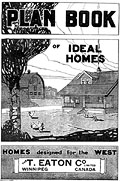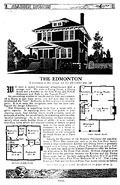The T. Eaton Co. Ltd.
The Eaton's catalogue was the shopping mall for farm families in
the
early 1900s, the settlement period of the Canadian prairies. Coveralls for
dad,
a new dress for mom, and a special Christmas present for the kids, all
came from
Eaton's in Winnipeg. The catalogue also supplied almost everything
for
the house, and, from 1910 to 1932, the house itself.
The house portion of Eaton's merchandise was a Western Canadian
phenomenon
only. Houses were advertised only in the Winnipeg catalogue and in special
plan
books. The advertisements showed Douglas Fir trees, seven feet in diameter
and
200 feet to the first limb. The lumber was without knots and came from
trees
that would not be cut today.
| |
 |
|
| |
 Eaton's
Plan Book of Ideal Homes, 1919, cover. Eaton's
Plan Book of Ideal Homes, 1919, cover.
|
|
| |
|
|
|
The mail-order house business worked like this: A few houses were
listed in
the catalogue as a teaser. The catalogue advertised free plan books that
gave
complete details about the houses: an artist's sketch, floor plan,
and
information on lumber, doors, windows, flooring, and hardware. Few of the
plan
books exist today because they were distributed free of charge.
Once the customer selected a house, the blueprints were purchased from
the
plan book for $2.50, although when competition appeared, the cost dropped
to
$1.00. When a house was ordered, the cost of the blueprints was subtracted
from
the invoice.
| |
 |
|
| |
 The "Eastacre," Eaton's
Plan Book of Ideal Homes, 1919. The "Eastacre," Eaton's
Plan Book of Ideal Homes, 1919.
|
|
| |
|
|
|
And order they did. Hundreds of Eaton homes dot the landscape in
Western Canada,
many serving the fourth or fifth generation of the same family, on the
same quarter
section of land. The lumber came by boxcar from British Columbia and the
millwork
came from Winnipeg. Freight was paid to the nearest railway station and
the lumber
was hauled to the farm by team and wagon.
Eaton's sold at least 40 different house plans. While the large
two-and-a-half-storey
square house is most often referred to as an Eaton's house, all
shapes
and sizes were available. The most common type was the one-and-a-half
storey,
sometimes referred to as the semi-bungalow.
| |
 |
|
| |
 "Eastacre," built
in 1916 by Alex Dunlap, in Harris, Saskatchewan, June 1999. "Eastacre," built
in 1916 by Alex Dunlap, in Harris, Saskatchewan, June 1999.
|
|
| |
|
|
|
Very few single-storey houses remain, but the Art Dunlap house near
Harris,
Saskatchewan, shows how durable the houses were. The Dunlap house was
built in
1916 and has been empty since 1956, but it still stands straight and
proud.
On the other end of the spectrum was the large two-and-a-half-storey
house.
A typical example still serves the Chris and Kathleen Bolink family near
Monarch,
Alberta.
The most popular type of Eaton's house was the one-and-a-half
storey,
and of those the most common style still in use in Western Canada was the
Earlsfield.
It first appeared as Plan 68 in the 1912 spring-and-summer catalogue with
a list
price of $696.50, f.o.b. the mill (freight on board, i.e., cost of freight
added).
In 1916, it was called Modern Home #668 and cost $887.50, with freight
paid for
the lumber, but freight charged for paint, hardware, nails, and paper from
Winnipeg.
Adding indoor plumbing cost another $150; hot-air heating was $90. In the
1919
and 1920 plan books, it was listed as the Earlsfield, but no price was
given.
In 1919 and 1920, all Eaton's houses were given a name starting
in Ea,
thus, the Eatoncourt, Eastbourne, Easton, Eager, Earlswood, and
Earlscourt, to
name a few. But, the most common was the Earlsfield. Can you imagine the
"think
tank" sessions required to come up with all those names starting
with Ea?
| |
 |
|
| |
 The "Earlsfield," Eaton's
Plan Book of Ideal Homes, 1919. The "Earlsfield," Eaton's
Plan Book of Ideal Homes, 1919.
|
|
| |
|
|
|
|
| |
 |
|
| |
 "Earlsfield," built
by Martin and Katie McGrath near Fielding, Saskatchewan, and now lived
in by their son Kevin, April 1999. "Earlsfield," built
by Martin and Katie McGrath near Fielding, Saskatchewan, and now lived
in by their son Kevin, April 1999.
|
|
| |
|
|
|
|
| |
 |
|
| |
 Invoice
for materials from Eaton's for McGrath home, Fielding, Saskatchewan. Invoice
for materials from Eaton's for McGrath home, Fielding, Saskatchewan.
|
|
| |
|
|
|
|
Not all houses that look like the Earlsfield were strictly
Eaton's.
Some just used the plan and sourced lumber elsewhere; some came from
United Grain
Growers. Nevertheless, the Earlsfield is a distinctive design not easily
forgotten.
In addition to the McGrath home in Fielding, Saskatchewan, Earlsfield
houses
are known in Alberta in Edmonton, Consort, Mannville, Irma, Nobleford,
Viking,
Coronation, Camrose and Carrot Creek. In Saskatchewan they were found in
Conquest,
Wawota, Lafleche, Central Butte, Lancer, Griffin, Craik, Eastend, Cabri,
Wapella,
Creelman, Tisdale, Star City, Ponteix, Reford, Verwood, Elrose, Maple
Creek and
North Battleford; and in Manitoba in Glenboro, Killarney, Holland, and
Shoal
Lake.
A common misconception about the Eaton's houses is that they were
prefabricated.
Although they were shipped as a single item, they were not prefab; the
lumber
was not even precut. Other companies, such as the Canadian Aladdin Co.
Ltd.,
did have precut houses and one company shipped prefab materials.
|
Canadian Aladdin Co. Ltd.
The largest company in the mail-order house business in Canada was the
Canadian
Aladdin Co. Ltd. with its head office in the CPR building in Toronto. It
was
a branch plant of the American Aladdin Company headquartered in Bay City,
Michigan.
The original name of Canadian Aladdin was Sovereign Construction (after
founders
O. E. and W. J. Sovereign); the original name of Aladdin Co. was North
American
Construction Ltd.
| |
 |
|
| |
 The "Edmonton," Aladdin
Homes: Sovereign System, 1919, p. 30. The "Edmonton," Aladdin
Homes: Sovereign System, 1919, p. 30.
|
|
| |
|
|
|
In addition to the head office in Toronto, Canadian Aladdin had offices
in
Saint John, Winnipeg, and Vancouver, with mills in Ontario, New Brunswick,
and
British Columbia. Whereas Eaton's was only in the mail-order house
business
from 1910 to 1932, and only in Western Canada, Canadian Aladdin did
business
from coast to coast from about 1905 to 1952. Canadian Aladdin was less
well known
than Eaton's, but it was much bigger in the mail-order house
business.
Canadian Aladdin houses were precut at the factory and shipped to the
railway
station closest to the customer. The lumber and materials were accompanied
by
a detailed set of blueprints and construction manual. Aladdin boasted that
anyone
who could swing a hammer could build an Aladdin Home and they offered to
pay
$1 per knot for every knot you could find in a carload of Aladdin lumber.
Imagine
that guarantee today: The lumberyard would owe us money.
| |
 |
|
| |
 An
Aladdin "Edmonton" owned by Les and Shannon Dawe south of Dinsmore,
Saskatchewan,
March 2000. An
Aladdin "Edmonton" owned by Les and Shannon Dawe south of Dinsmore,
Saskatchewan,
March 2000.
|
|
| |
|
|
|
Canadian Aladdin homes were a quality item and hundreds of them likely
still
exist across Canada. Research into Canadian Aladdin homes is ongoing, and
the
author, who has an extensive collection of Aladdin catalogues, is
currently identifying
Aladdin homes.
Think you might have an Eaton's or Aladdin home? Contact Les
Henry to
obtain a copy of the popular book Catalogue Houses: Eatons' and
Others
($38.51, tax and shipping included) or to identify your home: Henry
Perspectives,
143 Tucker Crescent, Saskatoon, Saskatchewan S7H 3H7, or by email: jleshenry@shaw.ca.
|